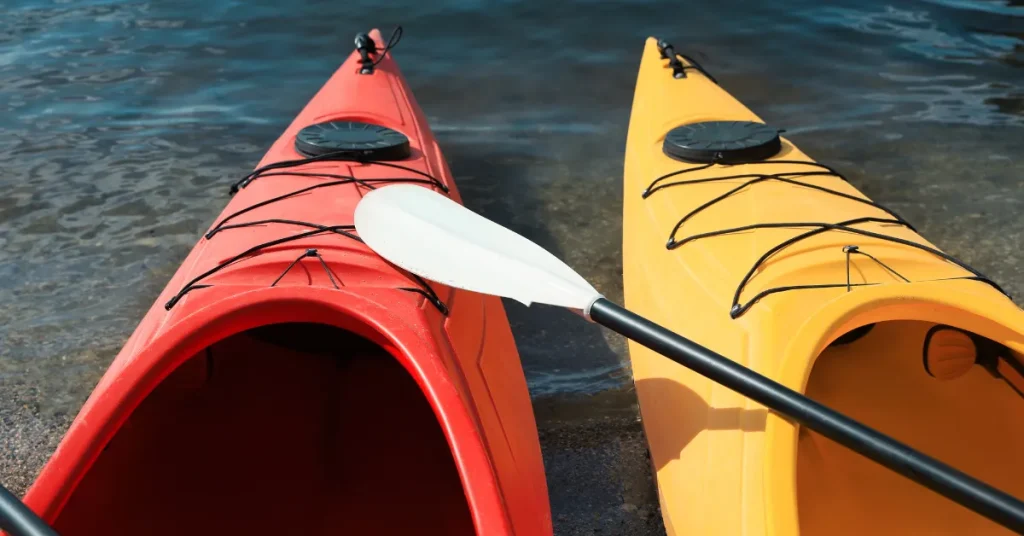Most kayaks are between 24 to 32 inches wide. Recreational models tend to be broader for greater stability.
Choosing the correct kayak width is essential for both comfort and performance. A kayak’s width, also known as its beam, greatly influences its stability on the water.
Wider kayaks typically offer more stability, which is ideal for beginners, photographers, or fishers who appreciate a solid platform.
Conversely, narrower kayaks are designed for speed and agility, suiting more experienced paddlers looking to cover distances efficiently.
Throughout the selection process, potential buyers should also consider the type of kayaking they plan to do, whether it’s serene lake paddling or navigating choppy sea waters. Understanding this key aspect ensures an enjoyable and safe kayaking experience.

Dimensions Matter In Kayaking
When choosing a kayak, knowing its width is key. The width of a kayak influences stability, speed, and maneuverability. Understanding this helps paddlers select the right kayak for their needs.
Why Size Affects Performance
Kayaks come in various sizes. The width—not just the length—impacts how they perform. Wider kayaks offer more stability, making them beginner-friendly. They’re also suitable for fishing or leisurely tours.
Narrow kayaks slice through water faster. This makes them better for racing or long-distance trips. Yet, they require more skill to balance. The right width depends on the user’s experience and purpose.
General Kayak Width Ranges
Kayak widths vary by type. Here’s a general guide:
- Recreational Kayaks: 26-30 inches (66-76 cm) wide.
- Touring Kayaks: 22-25 inches (56-64 cm) wide.
- Sea Kayaks: 20-22 inches (51-56 cm) wide.
- Whitewater Kayaks: 23-25 inches (58-64 cm) wide.
For specific activities, choose a width that suits those conditions. Always consider width alongside length and hull design.
Types Of Kayaks And Their Widths
Kayaks come in many shapes and sizes. Width, or ‘beam’, affects stability and performance. Understanding the different types of kayaks and their widths helps select the right kayak for your needs. Let’s dive into the world of kayaks and explore how wide they can be.
Recreational Kayaks: Comfort And Stability
Recreational kayaks are known for their wide and stable design. They typically measure between 27 to 30 inches wide. This width makes them ideal for beginners or those looking for a relaxed paddling experience. Below are key features:
- Wide hull for increased stability
- Spacious cockpits for easy entry and exit
- Perfect for calm lakes and rivers
Touring Kayaks: Speed And Efficiency
Touring kayaks offer a sleeker design for efficiency. They range from 22 to 25 inches wide. This narrower build allows for faster speeds and better straight-line tracking on longer trips. Features include:
- Narrow hull for speed
- Increased length for smooth tracking
- Designed for open waters like seas or large lakes
Fishing Kayaks: Space And Stability
Fishing kayaks need room for gear and steady control. Widths here can soar up to 36 inches or more. The extra width provides a stable platform for anglers to cast and reel in fish with confidence. Advantages are:
- Ample storage for fishing equipment
- Very stable to prevent tipping
- Often equipped with mounts for accessories
Measuring Your Kayak’s Width
Understanding the exact width of a kayak can enhance its stability and your comfort. Whether shopping for a cover, planning transportation, or modifying your vessel, knowing this measurement is vital. Dive in as we explore how to measure your kayak’s width accurately.
Tools For Accurate Measurements
Gathering the right tools is the first step to accurate kayak measurements. For precise results, you will need:
- Tape measure: Flexibility for curves
- Ruler or Straight edge: Helps with alignment
- Notepad: For recording measurements
- Marker: To indicate measurement points
Step-by-step Measuring Guide
With tools in hand, follow these simple steps to measure your kayak’s width:
- Place kayak on a level surface.
- Locate the widest point, usually around the cockpit.
- Place ruler or straight edge across the kayak at this point.
- Extend tape measure across the ruler to span the kayak’s width.
- Read the measurement where the tape meets the kayak’s edges.
- Record the width on your notepad.
Repeat the process if necessary to confirm accuracy. Boldly note the kayak’s width for future reference, ensuring ease of access when needed.
Choosing The Right Width For Your Kayak

Choosing the right width for your kayak ensures a great time on the water. A kayak’s width affects stability, comfort, and performance.
Finding the perfect balance depends on your body shape and where you plan to paddle. Read on to learn how to select a kayak that fits your needs like a glove.
Considerations For Body Type And Comfort
Kayak width should match your body size for comfort and control. A wider kayak offers more room and stability, which is good for larger paddlers. Smaller paddlers may prefer narrower kayaks for easier handling. Here are some tips:
- Measure your hip width to ensure a snug but comfortable fit.
- Consider leg length for enough space to stretch and move.
- Test for ease of entry and exit to find a kayak you can manage.
Water Conditions And Kayak Width
Your paddling environment influences the ideal kayak width. Flatter, wider kayaks give better stability on calm waters. Narrow kayaks cut through waves and are better suited for rough waters. Here are factors to consider:
| Water Type | Recommended Width |
| Calm lakes and rivers: | Wider kayaks for stability. |
| Open seas or rapid rivers: | Narrow kayaks for control. |
Balancing Stability And Speed
A kayak’s width impacts its stability and speed. A broader kayak is more stable but slower. A narrower kayak is faster but may feel tippy.
Your choice depends on your confidence and skill level. Beginners may favor stability while experienced kayakers can handle less stability for more speed. Keep these points in mind:
- Wider kayaks are stable and great for leisure or fishing.
- Narrower kayaks are agile and best for touring or racing.
- Mid-width kayaks offer a balance, suitable for various activities.
Modifications And Accessories For Kayak Width
Kayak width not only impacts stability but also influences performance. While most kayaks come in a standard width, sometimes you might want modifications.
This ensures your ride fits your specific needs on the water. Here we explore add-ons and techniques to adapt the width of your kayak.
Outriggers For Added Stability
Outriggers provide extra width, creating more balance. These handy tools are perfect for fishermen or photographers. They enable you to focus on your activity, not tipping over. Installing them is usually straightforward:
- Attach outriggers on each side of your kayak.
- They give you a broader footprint on the water.
- They are great for rough water or when you’re standing.
Paddling Techniques For Narrower Designs
Narrower kayaks present a challenge but can move faster. To ensure you stay stable, refine your paddling:
- Use short, steady strokes.
- Keep your stroke close to the kayak for better tracking.
- Practice makes perfect for managing these designs.
Common Myths About Kayak Width

Kayak width often sparks debates among paddlers. People hold strong beliefs that can lead to common myths. It is vital to dispel these myths for a better understanding of what makes an ideal kayak.
Wider Is Always Better: Fact Or Fiction?
A widespread myth is that a broader kayak translates to better stability. This statement is both true and false.
- A wide kayak might feel more stable in calm waters.
- It often struggles with agility and speed compared to a narrower one.
Consider these points:
| Activity | Width Preference |
| Fishing | Wider |
| Racing | Narrower |
Balance your needs before deciding whether broader is better for you.
The Impact Of Hull Shape On Width Perception
The shape of the kayak’s hull can change how we perceive its width. Two kayaks with the same width might feel different due to their hull designs.
- Flat hulls enhance stability but can feel tippy to beginners.
- Rounded hulls are easier to maneuver, which may seem less stable.
- V-shaped hulls cut through water and give an illusion of being narrow.
Base your choice on the type of water you will be navigating.
Understanding these considerations can help you choose the right kayak width for your adventure!
FAQs About How Wide Is A Kayak
What Are The Standard Dimensions Of A Kayak?
Standard kayak dimensions vary, with recreational kayaks typically measuring 10 to 12 feet long and 26 to 30 inches wide. Sea kayaks are longer, around 12 to 24 feet, with a narrow width of 18 to 26 inches to aid in swift movement.
Is A 30 Inch Wide Kayak Stable?
A 30 inch wide kayak generally offers good stability due to its wider hull design, making it suitable for beginners and calm waters.
How Wide Is A 12 Ft Kayak?
A typical 12 ft kayak is about 24 to 30 inches wide, ensuring stability and maneuverability on the water.Fishing kayaks typically measure between 30 to 40 inches in width for stability and space.
How Wide Is A Fishing Kayak?
Fishing kayaks typically measure between 30 to 40 inches in width for stability and space.
Conclusion
Understanding kayak width is essential for stability and performance on the water. Typical kayaks range from 24 to 36 inches across. Your choice should align with intended use and personal comfort.
Picking the right width enhances your paddling adventure. Dive into kayaking with confidence, knowing you’ve got the perfect fit!
Resources:
1. https://www.nps.gov/piro/planyourvisit/kayaking.htm
